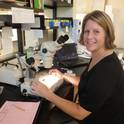The cephalopods of the wider Caribbean region (western central Atlantic) were examined in terms of distribution and ecological importance. In all, 4190 preserved cephalopod specimens were identified and catalogued to produce regional maps of cephalopod distribution within the wider Caribbean. Regional species richness was examined with respect to Rapoport's rule (RR) and to determine possible cephalopod hotspots in the region. Rarefaction curves were used to normalize the samples of various size collected throughout the wider Caribbean. Cephalopods of the wider Caribbean within latitudinal bands from 8 to 3°N do not support RR because they exhibit increasing species richness with increasing latitude. Eight subareas were chosen to compare species richness. Regionally, species richness appears to be patchy, with cephalopods concentrated more off the eastern Florida coast. There is a need for increased sampling throughout the wider Caribbean. Areas were lacking in samples, especially the central and southeastern parts of the region. There is a need to explore the systematics, life histories, and distribution patterns for this group of organisms in future.
Article
Cephalopod species richness in the wider Caribbean region.
USF St. Petersburg campus Faculty Publications
Document Type
Article
Publication Date
2010
Disciplines
Abstract
Language
en_US
Publisher
Oxford University Press
Creative Commons License
Creative Commons Attribution-Noncommercial-No Derivative Works 4.0
Citation Information
Judkins, H.L., Vecchione, M., Torres, J., & Roper, C.F.E. (2010). Cephalopod species richness in the wider Caribbean region. ICES Journal of Marine Science, 67(7), 1392-1400. DOI: 10.1093/icesjms/fsq092

Abstract only. Full-text article is available only through licensed access provided by the publisher. Published in ICES Journal of Marine Science, 67(7), 1392-1400. DOI: 10.1093/icesjms/fsq092